
Grozny is the capital city of Chechnya, Russia.

The First Chechen War, also referred to as the First Russo-Chechen War, was a struggle for independence waged by the Chechen Republic of Ichkeria against the Russian Federation from December 11th, 1994 to August 31st, 1996. This conflict was preceded by the battle of Grozny in November 1994, during which Russia covertly sought to overthrow the new Chechen government. Following the intense Battle of Grozny in 1994–1995, which concluded as a pyrrhic victory for the Russian federal forces, their subsequent efforts to establish control over the remaining lowlands and mountainous regions of Chechnya were met with fierce resistance from Chechen guerrillas who often conducted surprise raids.
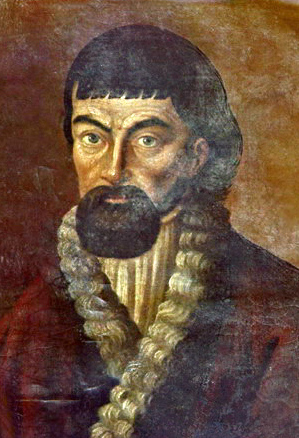
Yemelyan Ivanovich Pugachev was an ataman of the Yaik Cossacks and the leader of the Pugachev's Rebellion, a major popular uprising in the Russian Empire during the reign of Catherine the Great.
The history of Chechnya may refer to the history of the Chechens, of their land Chechnya, or of the land of Ichkeria.

Ingushetia or Ingushetiya, officially the Republic of Ingushetia, is a republic of Russia located in the North Caucasus of Eastern Europe. The republic is part of the North Caucasian Federal District, and shares land borders with the country of Georgia to its south; and borders the Russian republics of North Ossetia–Alania to its west and north and Chechnya to its east and northeast.

The Terek Cossack Host was a Cossack host created in 1577 from free Cossacks who resettled from the Volga to the Terek River. The local aboriginal Terek Cossacks joined this Cossack host later. In 1792 it was included in the Caucasus Line Cossack Host and separated from it again in 1860, with the capital of Vladikavkaz. In 1916 the population of the Host was 255,000 within an area of 1.9 million desyatinas.
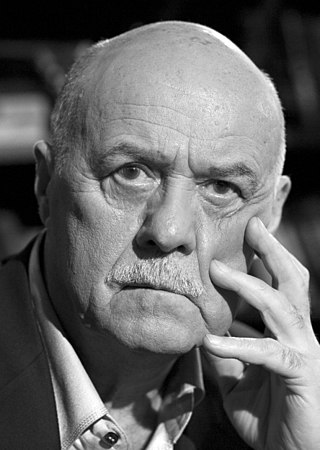
Stanislav Sergeyevich Govorukhin was a Soviet and Russian film director, actor, screenwriter, producer and politician. He was named People's Artist of Russia in 2006. His movies often featured detective or adventure plots.
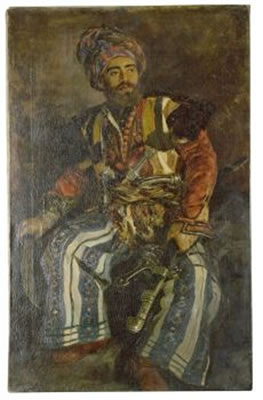
The Cossacks is a short novel by Leo Tolstoy, published in 1863 in the popular literary magazine The Russian Messenger. It was originally called Young Manhood. Both Ivan Turgenev and the Nobel prize-winning Russian writer Ivan Bunin gave the work great praise, with Turgenev calling it his favourite work by Tolstoy. Tolstoy began work on the story in August 1853. In August 1857, after having reread the Iliad, he vowed to completely rewrite The Cossacks. In February 1862, after having lost badly at cards he finished the novel to help pay his debts. The novel was published in 1863, the same year his first child was born.

Dauria is a 1971 Soviet historical adventure drama set in Siberia, Russia. Adapted from the novel of the same name by Konstantin Sedykh and directed by Viktor Tregubovich.

Ivan Aleksandrovich Pyryev was a Soviet and Russian film director, screenwriter, actor and pedagogue remembered as the high priest of Stalinist cinema. He was awarded six Stalin Prizes, served as Director of the Mosfilm studios (1954–57) and was, for a time, the most influential man in the Soviet motion picture industry.

And Quiet Flows the Don is a three-part Soviet epic film directed by Sergei Gerasimov based on the novel of the same title by Mikhail Sholokhov. The first two parts of the film were released in October 1957 and the final third part in 1958. The film tells the story of Russia's involvement in the World War I, the October Revolution, the Russian Civil War, the fate of ordinary people, the crumbling ideals of the Don Cossacks and the personal tragedy of the protagonist, Grigori Melekhov. The protagonist is described by Gerasimov as in fact "a man without a road, doomed by history."
Nikoloz Shengelaia was a Soviet Georgian film director.

The Chechen–Russian conflict was the centuries-long ethnic and political conflict, often armed, between the Russian, Soviet and Imperial Russian governments and various Chechen forces. The recent phase of the conflict started after the dissolution of the Soviet Union in 1991 and ended with the oppression of Chechen separatist leaders and crushing of the separatist movement in 2017.
Women of Ryazan or The Peasant Women of Riazan is a 1927 Soviet silent drama film directed by Olga Preobrazhenskaya and co-directed by Ivan Pravov, starring Kuzma Yastrebitsky, Olga Narbekova and Yelena Maksimova. This is the fourth feature film Preobrazhenskaya directed. In this film, "she reveals her belief in the strength of a simple plot, and her penchant for portraying folk traditions and for conveying a sense of the beauty and freshness of her native countryside."

Don Diego and Pelagia is a 1928 Soviet silent comedy drama directed by Yakov Protazanov.

Abrek Zaur is a 1926 Soviet silent Red Western directed by Boris Mikhin. The film's sets were designed by the art director Isaak Makhlis.

The 205th Separate Cossack Motor Rifle Brigade is a mechanized infantry brigade of the Russian Ground Forces. Part of the 49th Combined Arms Army, the brigade is based in Budyonnovsk, Stavropol Krai.
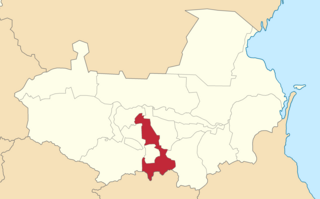
The Nazran okrug, known after March 1917 as the Ingush okrug, was a district (okrug) of the Terek Oblast of the Caucasus Viceroyalty of the Russian Empire, and after 1921, the Mountain ASSR of the Russian SFSR within the Soviet Union. The district was modest in its population of 59 thousand and size of approximately 1,500 square kilometres (580 sq mi), the smallest of all the Terek Oblast's subdivisions in both measures. The administrative centre of the district was the city of Vladikavkaz.

The Battle of Dadi-yurt the capture of the village of Dadi-yurt on 14 (26) September 1819 by order of General Yermolov. During the storm by the Russian forces, the village was completely destroyed.
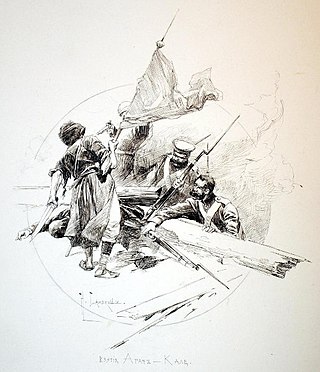
The assault on Germenchuk took place on 23 August 1832, one of the battles of the Caucasian War. Some 9,000 Russian troops under the command of General Velyaminov stormed the Chechen village, where they met 3,800 defenders.
















